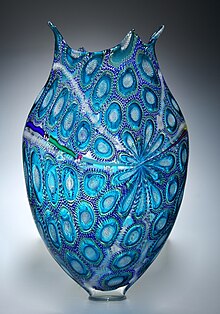
Studio glass is the modern use of glass as an artistic medium to produce sculptures or three-dimensional artworks in the fine arts. The glass objects created are intended to make a sculptural or decorative statement, and typically serve no useful function. Though usage varies, the term is properly restricted to glass made as art in small workshops, typically with the personal involvement of the artist who designed the piece. This is in contrast to art glass, made by craftsmen in factories, and glass art, covering the whole range of glass with artistic interest made throughout history. Both art glass and studio glass originate in the 19th century, and the terms compare with studio pottery and art pottery, but in glass the term "studio glass" is mostly used for work made in the period beginning in the 1960s with a major revival in interest in artistic glassmaking.
Pieces are often unique, or made in a small limited edition. Their prices may range from a few hundred to hundreds of thousands of dollars (US).[1] For the largest installations, the prices are in the millions.[2]
Modern glass studios use a great variety of techniques in creating glass artworks, including:
- ^ "Bonhams : 20th Century Decorative Arts". www.bonhams.com. Retrieved 2017-09-23.
- ^ "artnet.com Magazine Features – Art Market Guide 2003". www.artnet.com. Retrieved 2017-09-23.